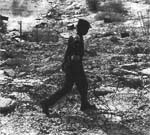The aftermath
 the testing of five nuclear devices on May 11 and May 13, 1998 - including a thermonuclear-boosted fusion bomb, a lighter but more powerful fission bomb of the type tested in May 1974, a low-yield nuclear device and two sub-critical tests - thrilled scientists and people alike. Heads of state and military strategists across the world are still debating the political implications of this development. But the less spectacular connotations - sourcing and handling of hazardous nuclear fuel, and achievements in design - have almost been ignored.
the testing of five nuclear devices on May 11 and May 13, 1998 - including a thermonuclear-boosted fusion bomb, a lighter but more powerful fission bomb of the type tested in May 1974, a low-yield nuclear device and two sub-critical tests - thrilled scientists and people alike. Heads of state and military strategists across the world are still debating the political implications of this development. But the less spectacular connotations - sourcing and handling of hazardous nuclear fuel, and achievements in design - have almost been ignored.
According to former chief of the Atomic Energy Commission (aec) M R Srinivasan, the tests were a positive step in the miniaturisation of weapons. The sub-critical tests (in which no explosion occurred), he said, opened up possibilities of developing nuclear-tipped artillery shells.
But weaponisation, quite apart from the cost of producing a bomb, needs three inputs.First, delivery systems that can drop these bombs on target, such as long-range missiles, fighter aircraft and nuclear-powered submarines. Second, sophisticated radar and early warning systems, and intelligence-gathering systems to anticipate potential attacks - technically known as command, control, communications and intelligence systems. Developing and installing these requires huge investment, to the tune of Rs 15,000-20,000 crore. Given the immense cost of weaponisation, the implications of the tests for civilian use of nuclear power deserve more attention.
A third requirement, basic to both weapons development and civilian uses is fuel - plutonium, enriched uranium and tritium. The sourcing of the fuel used in these tests has been kept under wraps. Former chairperson of the aec, P K Iyengar, who was involved in the project, admitted that "indigenously enriched uranium" was used in the low-yield device.
The actual sources are open to speculation. T S Gopi Rethinaraj, writing in Jane's Intelligence Review, said that the tritium was distilled from heavy water used in reactors. This was done at a fraction of what it cost us scientists (us $7 billion), and in just two years. Others speculated that most of the fissile material probably came from the Bhabha Atomic Research Centre (barc).
The objective of barc was nuclear-powered generation of electricity. With low funds for research in this area, this has taken a backseat. But the tests have thrown up possibilities of evolving new materials (alloys of plutonium; tritium and enriched uranium), and developing fast breeder plants and thermonuclear reactors.
In fission (light-water and heavy-water) reactors, the double-neutron variant of hydrogen, tritium, is produced as a result of bombardment of a number of elements and by fission of the fuel. Handling of tritium, which can escape into the atmosphere and pose a health hazard, has been a significant operational problem in such reactors.
But management of tritium in fuel-reprocessing plants and thermonuclear reactors is even more difficult. In thermonuclear reactors, the quantities of tritium handled are considerably greater than those in fission-powered reactors. Half the tritium in these reactors is produced in the 'lithium-beryllium-fluorine blanket' that surrounds the core, where fusion takes place. The other half comes from the unburned tritium in the plasma (the core). In both cases tritium-separating processes are required. Tritium and deuterium (the single-neutron isotope of hydrogen) also need to be injected into the plasma to offset losses to the exhaust stream and the fusion reaction. All this makes management of tritium a big problem.
Thermonuclear reactors also use plutonium.An extremely hazardous metal, plutonium is not found naturally. To make use of this artificial metal, it has to be combined with other stable metals like aluminium. Despite this, the possibility of inadvertently assembling a critical mass is greater with plutonium than with other fissionable metals because it has a smaller critical mass. For this reason, design and management of thermonuclear reactors is much more difficult.
The recent tests at Pokharan showed that India has the know-how to improve and change the design of nuclear reactors. Says S V Subramanyam of the Indian Institute of Science, Bangalore: "It is every scientist's dream to build a reactor driven by thermonuclear reaction. If one can contain the fusion reaction, there will be no dearth of power." The tests - and the lessons learnt -showed that India today is much closer to realising this dream.
Related Content
- Protecting maternal, newborn and child health from the impacts of climate change: call for action
- Evidence-based public–private collaboration in the health sector: the potential for collaborative governance to contribute to economic recovery from COVID-19 in Asia
- SDG 11: sustainable cities and communities
- South Asia’s path to resilient growth
- The cost of delay: why finance to address loss and damage must be agreed at COP27
- Improving social protection portability for migration-affected children: spotlight on Chhattisgarh
